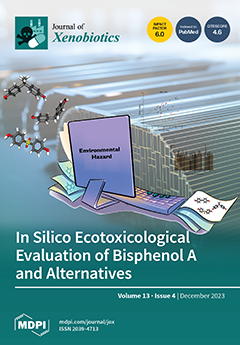Essential oils from five
Baccharis species were screened for their toxicity and biting deterrence/repellency against yellow fever mosquito,
Aedes aegypti (L.), and imported fire ants, including
Solenopsis invicta Buren (RIFA),
Solenopsis richteri Forel (BIFA) and their hybrids (HIFA).
Baccharis microdonta DC. and
B.
[...] Read more.
Essential oils from five
Baccharis species were screened for their toxicity and biting deterrence/repellency against yellow fever mosquito,
Aedes aegypti (L.), and imported fire ants, including
Solenopsis invicta Buren (RIFA),
Solenopsis richteri Forel (BIFA) and their hybrids (HIFA).
Baccharis microdonta DC. and
B. punctulata DC. at 10 µg/cm
2 showed biting deterrence similar to DEET,
N,
N-diethyl-
meta-toluamide at 25 nmol/cm
2, whereas the repellency of
B. pauciflosculosa DC.,
B. sphenophylla Dusén ex Malme and
B. reticularioides Deble & A.S. Oliveira essential oils was significantly lower than DEET against mosquitoes. Two major compounds from the active essential oils, kongol and spathulenol, also exhibited biting deterrence similar to DEET against mosquitoes. The highest toxicity exhibited against mosquitoes was by
Baccharis punctulata essential oil (LC
50 = 20.4 ppm), followed by
B. pauciflosculosa (LC
50 = 31.9 ppm),
B. sphenophylla (LC
50 = 30.8 ppm),
B. microdonta (LC
50 = 28.6 ppm), kongol (LC
50 = 32.3 ppm), spathulenol (LC
50 = 48.7 ppm) and
B. reticularioides essential oil (LC
50 = 84.4 ppm).
Baccharis microdonta essential oil showed repellency against RIFA, BIFA and HIFA at 4.9, 4.9 and 39 µg/g, respectively.
Baccharis microdonta essential oil also showed toxicity with LC
50 of 78.9, 97.5 and 136.5 µg/g against RIFA, BIFA and HIFA, respectively, at 24 h post treatment.
Full article






